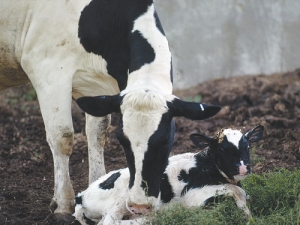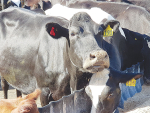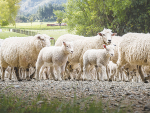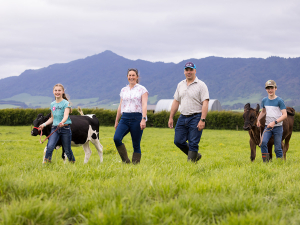We can directly affect these events and on her potential as a production animal. This article discusses the immediate care of the newborn dairy calf, and identifies at-risk animals and how to manage them.
The ‘normal’ calf
It is important to recognise the behaviour of normal calves in the first few hours of life so that abnormal calves can be identified promptly. Normal calves should:
- Take their first breath within 30 seconds of birth.
- Lift their head within 1-2 minutes.
- Roll onto their chest within 2 minutes.
- Attempt to stand within 15 minutes.
- Begin shivering within 30 minutes.
- Be standing within 1 hour.
- Be suckling within 2 hours of birth.
Routine procedure for a ‘normal’ calf
Position
If they haven’t already done so within a few minutes of birth, all calves should be positioned on their chest with their hind legs pulled forward on either side of their body. This position provides equal opportunity for both lungs to fully inflate, allowing easier breathing for the newborn calf. The traditional method of hanging the calf upside down or swinging the calf by its back legs is no longer recommended. It was originally thought that this practice allowed fluid to be cleared from the lower airways (lungs). In fact, the draining fluid observed is actually from the calf’s stomach. Fluid in the lower airways will not be cleared this way and instead will be absorbed by the lungs.
Airway
Clearing mucous from the nostrils and mouth will aid breathing. The head can also be positioned over a small bucket with the nose to the floor to allow drainage of mucous from the upper airways (nose and mouth).
Stimulate
There are many ways to stimulate a calf in order to make it breathe more vigorously. Pinching the nostrils, using a clean piece of straw to tickle the nostrils, pouring cold water into the ear, pinching and shaking of the windpipe high up in the calf’s neck to initiate a cough reflex and rubbing all over the calf’s body with a clean towel are all useful ways to stimulate calves to breathe.
The aim is to initiate deeper breaths as these will help clear any remaining fluid from the nose and mouth, which in turn will allow the lungs to be inflated more easily.
Temperature
When calves are born their body temperature will be slightly higher than normal. At birth, their rectal temperature should measure 38.8-39.4oC. This will decrease within the first 30 minutes of life to 38.3-38.8oC. In normal circumstances they should then be able to maintain this body temperature. However, calves born in cold weather and a damp environment are at risk of hypothermia. Calf coats, heat lamps and hair dryers can be used to help maintain body temperature, along with a clean, sheltered environment. Absence of shivering is a poor sign and indicates that assistance is required.
Navel
The navel (or umbilical cord) seen at birth is comprised of the umbilical vein and the urachus. The umbilical arteries retract back into the abdomen and are not seen externally. The function of these structures in the unborn foetus is to allow blood exchange between the dam and the foetus, and to remove waste products produced by the foetus. In the newborn calf these structures become redundant and eventually they degenerate. However, at birth the wet ‘open’ navel provides an entry point for infection, allowing bacteria to enter the blood stream of the calf with sometimes fatal consequences. Heart disease, pneumonia, joint ill and meningitis are some of the consequences of bacteria gaining entry to the blood via the navel.
Disinfection of the umbilical cord at birth helps reduce the incidence of these diseases. Iodine (7%) can be used as spray or in a teat dip cup. If using a teat dip cup, ensure the iodine is replaced frequently to avoid the dip becoming heavily contaminated with bacteria. Iodine-based teat dip generally contains 0.5% iodine and will be insufficient for navel disinfection. Teat-dip also contains emollients which can prevent the cord from drying.
Colostrum
An adequate volume of good quality first-milking colostrum (>=22 Brix) should be provided as soon as possible after birth. For example, a 40kg newborn calf should receive 4L of good quality colostrum within 12 hours of birth. This can be split into two feeds, with the first feed within two hours of birth. If only poor quality colostrum is available, then a higher volume will be required to avoid failure of passive transfer of immunity.
Observe and Record
All calves should be checked for abnormalities at birth. These include congenital deformities and induced trauma (fractures of the legs or ribs). All calves should be given a unique identification at birth (Farm ID tag, NLIS tag) and calving details permanently recorded. Such details can include calf ID, date of birth, dam ID, gender, assisted birth, twins and sire (if applicable).
Resuscitation
Calves requiring resuscitation are more likely to be delivered by farmers, not by vets. All farm staff should be trained in the resuscitation of newborn calves, using the appropriate equipment. Clean towels (ideally warmed), a hair dryer and a resuscitator are helpful items to have in the calving area.
Certain calves will be at-risk and are more likely to require resuscitation than others. These include calves with prolonged or difficult births due to disproportionate size, malpresentation, malpositioning or multiple births. Calves born by caesarean section are also considered at increased risk. All the ‘normal’ observed signs are likely to be delayed in these calves. For example, calves requiring an assisted birth may take 6-12 minutes to lift their head and roll onto their chest.
Attentive staff are critical to recognise these calves quickly. Signs indicative of a calf requiring resuscitation include swollen tongue or head, blue gums or tongue, slow, weak or absent breathing, flaccid body and poor suck reflex. Inactivity, hypothermia and lack of oxygen contribute to accumulation of waste products in the blood (acidosis), which further delays absorption of colostral antibodies in the gut of the calf.
Resuscitation begins with the routine for ‘normal’ calves described earlier.
If positioning, clearing of the airways and stimulation are insufficient and the calf is not responding, then mechanical ventilation is required. This not only delivers oxygen to the calf but will also help reduce acidosis. Mouth-to-mouth ventilation is not recommended due to the risk of transfer of potentially harmful bacteria. Instead, specifically designed resuscitators are recommended for this purpose.
The mask is placed over the calf’s nose while the head and neck of the calf is extended. It is important to close off the oesophagus on the left side of the calf’s neck so that air is delivered into the lungs when the cylinder is depressed and not into the stomach. This technique is not as effective as placing a tube into the windpipe to deliver oxygen by cylinder. However, specific training and equipment are required for this procedure.
The main problems with calves post-delivery are inactivity, low blood oxygen, accumulation of blood waste products (acidosis), hypothermia, low blood sugar (hypoglycaemia) and poor colostral transfer of immunity. Treatment is targeted at the specific problem:
- Position the calf correctly
- Clear the airways and assist with mechanical ventilation where necessary
- Stimulate and encourage movement
- Provide a warm environment
- Routinely disinfect the navel
- Feed warm colostrum by teat or oesophageal tube
- Record all calf details.
Collectively these actions will increase the chances of a positive outcome.
• Dr Gemma Chuck is a dairy vet working at The Vet Group in south west Victoria. She has a special interest in calf rearing and is working on a PhD in this at The University of Melbourne.


















